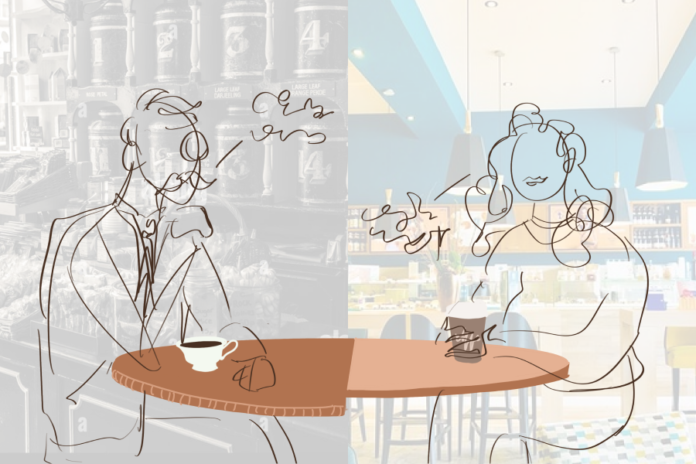Coffeehouses have been important spaces for promoting social equality, but still have work to do in being truly inclusive
By SUN YIE — arts@theaggie.org
Starbucks, Peet’s and Philz are a few names that students have grown to know and love in their fixations with coffee, perhaps to a degree where they can not function in their classes without their usual dose of espresso shots. Coffeehouses are places of innovation, enlightenment and the occasional caffeine-fueled meltdown provoked by exam anxiety. They are open to children and elders alike, thereby advertising themselves as welcoming hosts of a creative and open environment.
Coffeehouses prided themselves in transcending the imposed boundaries between social classes in 17th and 18th century England, according to Tom Standage’s “A History of the World in 6 Glasses.” Yet coffeehouses were not necessarily welcoming spaces for everyone. Coffeehouses were considered places to conduct not only business, but also places to hold political and philosophical discourse — exclusively for men.
Coffeehouses were, however, revolutionary in their accessibility for men of all social classes. According to Standage, they were considered a great equalizer, as a “dish of coffee” was worth a penny, so even men of lower socioeconomic status could participate and contribute in these public spheres. Men who would later become acclaimed historical influences, like Isaac Newton and Jonathan Swift, would also frequent these establishments to promote scientific and philosophical conversations.
Because Englishmen realized coffee was an appropriate substitute for alcohol, it became a valued commodity, with coffeehouses obscuring the popularity of alehouses and alcohol. Before coffee, ale was England’s choice of beverage, but alehouses were noisier and less pragmatic to conduct business and maintain productive conversations in. During their transition from dependency on alcohol to dependency on caffeine, Englishmen ushered in a society of sobriety, which caused a few scholars to then consider coffee as an ultimate panacea for society’s ailments, even considering it as a potential cure for miscarriages.
Women of the upper class were not welcome in coffeehouses, despite their numerous protests. In “A Woman’s Petition Against Coffee,” published in 1672, women addressed their concerns about the effects that caffeine had on their husbands and other men, citing men’s habit of gossiping about women. This comparison might have been drawn to effeminize them in order to turn them away from their caffeine fixation. However, their efforts proved to be fruitless, according to Standage’s “A History of the World in 6 Glasses,” as men continued to frequent these establishments.
Given the globalization and modernization of coffee and coffeehouses, coffeehouses now are far more inclusive spaces than before, according to Mark Pendergrast’s book, “Uncommon Grounds.” Through the thorough and lively discourse shared among colleagues, regardless of gender, it is clear that no one thinks twice when they see a woman in a coffeehouse, nor do they find it strange when women participate in academic discourse with men.
Lisa Tran, a fourth-year computer science major, and Ryan Chang, a fourth-year mechanical engineering major, both said they enjoy participating in conversations about their classes over a cup of coffee at the CoHo or Starbucks.
“I see both women and men [in coffeehouses] struggling over classwork and it’s always best to do that over a cup of coffee,” Tran said. “I feel like coffeehouses bring us together in a way that other public spaces don’t, and when I talk to my peers, I’m not thinking about their gender and I can say they don’t see me in that way either. We’re equal peers, regardless of gender.”
Chang echoed similar sentiments as Tran.
“Yeah, I mean, I feel like we’re all in this together,” Chang said. “You say coffeehouses weren’t available to women back then, but this is 2022 so for that to be true in the present seems a little ridiculous to me.”
In this sense, many do not view coffeehouses any longer as gendered spaces, but whether they are now truly inclusive to everyone is still to be considered. After the arrest of two Black men for “trespassing” at Starbucks in 2018, the coffee chain faced backlash. Kevin Johnson, the CEO of Starbucks, issued a personal apology to the two victims in 2018 and subsequently claimed to ensure that store managers would undergo more training, especially against unconscious bias. After their accusations directed against the two Black men, Starbucks announced they would be closing “more than 8,000 company-owned stores” for a day to conduct racial bias education across the country to prove their commitment to their new diversity training.
Starbucks is a well-known chain of coffeehouses which people from all walks of life frequent and, as such, it is a place that should seek to foster a sense of community by dismantling prejudices levied against underrepresented groups, according to Pendergrast. Starbucks’ responsibility to create space for all communities can be traced back to coffeehouses in 17th and 18th century England, which sought to reduce the disparities of social classes between men, despite its inaccessibility towards women. However, the treatment of these two Black men makes clear that coffeehouses are not yet equitably accessible and thus need to make more cognizant efforts to connect to their communities.
Coffeehouses’ exclusivity has evolved to reflect pressing modern issues today. In 17th and 18th century England, women were the main group shunned from coffeehouses, and their protests were dismissed for a while.
Likewise, Black people struggle to be included in these spaces that promote equity as a public business, evidenced not just by the arrest of the two Black men at Starbucks but also in more covert ways. In an Instagram post, user Cydni Patterson explained the feeling of her family being “monitored” and unwelcome by her cafe managers. Additionally, in his Medium article, “Coffee Shop Racism,” Alfredo A. Weeks IV detailed his experience with racial profiling and exclusion at coffee shops, discussing “the stares” he feels and the barista “eyeing him,” further demonstrating undertones of hostility and microaggressions against Black people in coffeehouses.




